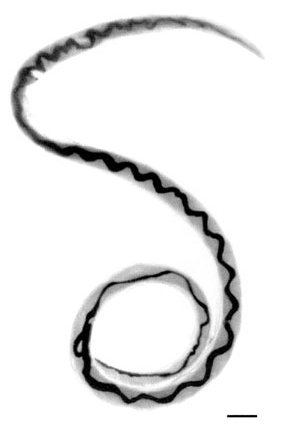Angiostrongylidae
Angiostrongylidae is a family of nematodes, or roundworms, that are primarily parasitic in nature. They belong to the order Strongylida, and are known to infect a variety of hosts, including humans, other mammals, and mollusks.
Overview[edit | edit source]
The family Angiostrongylidae includes several genera, such as Angiostrongylus, Aelurostrongylus, and Parastrongylus, among others. These parasites are typically characterized by their complex life cycles, which often involve intermediate and definitive hosts.
Life Cycle[edit | edit source]
The life cycle of Angiostrongylidae typically begins when the eggs are excreted in the feces of the definitive host. These eggs then hatch into larvae, which are ingested by an intermediate host, usually a mollusk. The larvae mature within the intermediate host, and are then ingested by the definitive host, where they mature into adults and reproduce.
Pathology[edit | edit source]
Infections caused by Angiostrongylidae can lead to a variety of diseases, depending on the species of parasite and the host. For example, Angiostrongylus cantonensis, also known as the rat lungworm, can cause eosinophilic meningitis in humans. Similarly, Aelurostrongylus abstrusus, or the cat lungworm, can cause respiratory disease in cats.
Diagnosis and Treatment[edit | edit source]
Diagnosis of Angiostrongylidae infections typically involves the identification of eggs or larvae in the feces of the host. Treatment usually involves the administration of anthelmintic drugs, such as ivermectin or fenbendazole, which are designed to kill the parasites.
Prevention[edit | edit source]
Prevention of Angiostrongylidae infections primarily involves controlling the population of intermediate hosts, such as snails and slugs, and preventing definitive hosts from ingesting them. This can be achieved through the use of molluscicides, or by maintaining clean and hygienic living conditions for pets.
See Also[edit | edit source]
References[edit | edit source]
Search WikiMD
Ad.Tired of being Overweight? Try W8MD's physician weight loss program.
Semaglutide (Ozempic / Wegovy and Tirzepatide (Mounjaro / Zepbound) available.
Advertise on WikiMD
|
WikiMD's Wellness Encyclopedia |
| Let Food Be Thy Medicine Medicine Thy Food - Hippocrates |
Translate this page: - East Asian
中文,
日本,
한국어,
South Asian
हिन्दी,
தமிழ்,
తెలుగు,
Urdu,
ಕನ್ನಡ,
Southeast Asian
Indonesian,
Vietnamese,
Thai,
မြန်မာဘာသာ,
বাংলা
European
español,
Deutsch,
français,
Greek,
português do Brasil,
polski,
română,
русский,
Nederlands,
norsk,
svenska,
suomi,
Italian
Middle Eastern & African
عربى,
Turkish,
Persian,
Hebrew,
Afrikaans,
isiZulu,
Kiswahili,
Other
Bulgarian,
Hungarian,
Czech,
Swedish,
മലയാളം,
मराठी,
ਪੰਜਾਬੀ,
ગુજરાતી,
Portuguese,
Ukrainian
Medical Disclaimer: WikiMD is not a substitute for professional medical advice. The information on WikiMD is provided as an information resource only, may be incorrect, outdated or misleading, and is not to be used or relied on for any diagnostic or treatment purposes. Please consult your health care provider before making any healthcare decisions or for guidance about a specific medical condition. WikiMD expressly disclaims responsibility, and shall have no liability, for any damages, loss, injury, or liability whatsoever suffered as a result of your reliance on the information contained in this site. By visiting this site you agree to the foregoing terms and conditions, which may from time to time be changed or supplemented by WikiMD. If you do not agree to the foregoing terms and conditions, you should not enter or use this site. See full disclaimer.
Credits:Most images are courtesy of Wikimedia commons, and templates Wikipedia, licensed under CC BY SA or similar.
Contributors: Kondreddy Naveen, Prab R. Tumpati, MD

